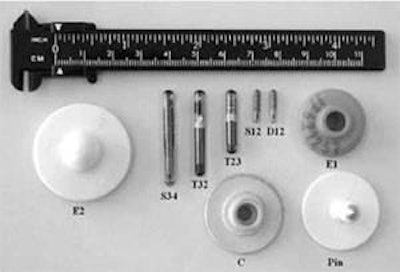
Spanish research supported by the European Commission has offered more insights into the choices available for identifying pigs electronically. The work made clear that the type of electronic device used is only part of the story. No less important is the method adopted for placing this so-called transponder (radio frequency transmitter-responder) on or under the animal's skin.
Indeed, the investigators from the animal science department at Universitat Autónoma de Barcelona came to the conclusion that the only appropriate method among those tested was to inject a transponder into the peritoneal cavity of the piglet. Provided that the device is large enough to have a suitable reading distance, they indicated, this way of attachment scores because the equipment is less likely to be lost on the farm and is easier to recover after slaughter.
To take remarks from the team's report in the Journal of Animal Science (J. Anim. Sci. 2005. 83:2215-2224), injectable transponders in the intraperitoneal position meet the requirements of an identification system for pigs that is permanent and unique, that does not produce apparent disturbances to the animals at application and that is tamper-proof. Application can be done easily soon after birth. The team recommended using a transponder not less than 23mm in length, saying that a shorter type would be too short on reading distance and would give difficulties in post-slaughter recovery.
The Barcelona researchers tried a new intraperitoneal injection technique for their tests at a co-operative's pig unit near Lerida in Spain. After placing the baby pig (7-14 days old) on its back on a castration board, they inserted the needle between its 4th-5th teats on the left side. The transponder was released after the needle had traversed the piglet's abdominal wall.
Testing on a total of 557 piglets compared this with 7 other identification options, altogether covering 5 passive-type injectable transponders as well as a conventional plastic button in the ear and 2 electronic ear-tags. The full-duplex and half-duplex transponders ranged from 12mm long and about 2mm diameter. Injectable types were inserted either into the peritoneum or in the base of the ear-flap, using single-shot or multi-shot injectors.
On-farm losses of the ear-implanted electronic tags confirmed earlier research results by increasing with transponder size. By contrast, the size of the device did not affect losses on the farm for intraperitoneally injected transponders; in fact, only one loss was recorded out of 309 piglets treated. Similar observations related to breakages, with 1.5% of devices injected into the ear being broken compared with zero for those inserted in the peritoneum. Mounting the microchip on an ear-tag resulted in more being lost between early life and slaughter than was found for a conventional identity button in the ear, which the team attributed to the greater weight and dimensions of the electronic versions.
All externally mounted tags had similar losses during transportation to the slaughterhouse (1.2%), but no losses were observed for the injectables. The time needed to recover a device after slaughter did not differ between ear-flap and intraperitoneal insertion. Over 80% of intraperitoneal transponders were recovered loose in the abdominal cavity, the rest simply falling on the floor. The injection site had more influence on losses and breakages during slaughtering, with ear implantation giving a loss rate of 6.4% against zero for intraperitoneal.
Modern markets demand traceability for meat as for other foods. Overall in this test, says the Spanish report, the trace-back element varied significantly according to the type of identification applied to the pig. For conventional ear buttons it worked out at 86.7%, whereas for electronic tags in the ear the range went from zero to 68.1%. Ear implantation was rated at 17.8% to 75.0% depending on the particular chip implanted. But intraperitoneal came out well on top with a 98-100% rating. The peritoneum method was highly effective for piglet identification and traceability, the report declares, ensuring the transfer of information from farm to slaughterhouse.
Now members of the same team have added to the evidence by describing in the Journal of Animal Science this year (J. Anim Sci. 2006. 84:2575-2581) an evaluation of pig traceability under on-farm conditions using several different identification technologies on 1822 pigs at 2 Spanish units. Here, the devices tried were visual ear buttons, electronic ear-tags (both half-duplex and full-duplex) and intraperitoneally injected transponders.
Equipment losses while still on the farm amounted to 0.8% for ear buttons and 1.9-2.7% for the external electronic alternatives. The loss rate for intraperitoneally injected transponders averaged 1.8%. Electronic failures occurred in some externally mounted tags, but not for those in the peritoneum. Readability was greater for visual than for electronic ear-tags, with the intraperitoneal transponders called intermediate in this respect.
The summary of the research states that electronic devices were in all cases easier and faster to read than the visual ear-tags. The ear buttons and the intraperitoneally injected transponders were retained efficiently under commercial pig-unit conditions. When readability and reading ease were also included as decision criteria, injectable transponders were preferred.

















